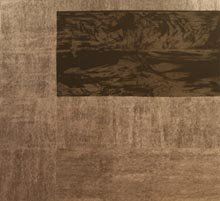Yogesh Rawal
dal 11/7/2007 al 15/8/2007
Segnalato da
11/7/2007
Yogesh Rawal
Aicon Gallery , New York
The artist creates untitled abstractions using paper collage, cellulose and synthetic resin. The final product has an almost photographic finish, and evokes a sophisticated understanding of light and shade.

Solo show
“…there is one fundamental on which Yogesh Rawal dwells, and it is the study of light.”
Yogesh Rawal’s creates untitled abstractions using paper collage, cellulose and synthetic resin.
The final product has an almost photographic finish. One is reminded of the conceptual
photography of Nasreen Mohamedi. Like Mohamedi, his imagery paradoxically describes a
sublime indeterminate realm on the precincts of iconic representation. But, unlike Mohamedi,
there is one fundamental on which Rawal dwells and that is the study of light. Rawal evokes a
sophisticated understanding of light and shade. His blocks of color and phantasmagoric shapes
bear witness to the myriad possibilities of creation with light. Everything from the clarity of Untitled
15, to the sharp contrast of Untitled 21 and to haziness of Untitled 20, his range is eloquently
conveyed. Some works play out their own ambiance, it seems as though they have an imaginary
spotlight installed. In this sense, his works emanate a peculiar completeness. And yet, as we turn
to the process of some of his panels, this completeness is harmoniously accompanied by
hollowness. Rawal’s use of tissue for example dematerializes his robust wooden support. Much
like how a clearstory connotes the spiritual lightness of the otherwise heavy and somber medieval
church, the dynamism of his lines and gliding quality of his materials render his works – but not
his efforts – weightless.
Rawal animates his ‘indeterminate realms’ by referring to them as inner conversations. Indeed,
his art suggests the immaterial world of the mind. While minimalist in intention, Rawal’s concerns
are less cerebral and rigid. Rawal has been compared to artists like Agnes Martin who infuse
their simple forms with attitudes stemming from certain Zen Buddhist philosophy. Unlike Martin
however, Rawal is not reacting to the sudden popularity of the East (in the West) that first
occurred in the 1950s. Instead, he is unveiling underlying ideals that have permeated the East
since time immemorial – but have become lost in the layers of history. His Zen inner self is
grounded in its local roots. Rawal often works in black and white but he does not hesitate to use
deep reds, browns and oranges. It seems he has a rather intuitive relationship with color.
Yogesh Rawal has had a varied career. He has excelled in various media and modes of art
practice: sculpture, print and mixed media. In the late 1970s, he studied at the prestigious Sir J.J
school of Arts then at the renowned l’ecole nationale superieure des beaux-arts in Paris. He has
won many awards and has exhibited all over India, in Europe and the United States. Rawal lives
in between Bhopal and Mumbai.
Opening Thursday, July 12, 2007 - 6:00pm - 9:00pm
Aicon Gallery
206 Fifth Avenue - New York
Free admission



